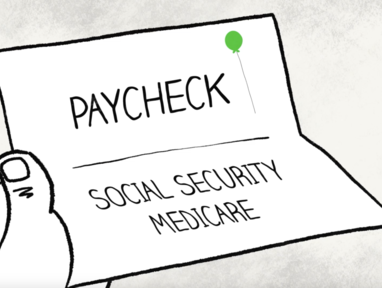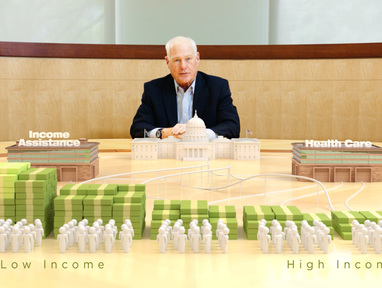The Social Security Trust Funds

Last week, the Board of Trustees for Social Security’s trust funds released its annual report on the financial state of the program. Its findings? The nation’s largest government program is quickly running out of money.
In 2021, Social Security spent $57 billion more than it collected in dedicated tax revenue and interest on its trust funds. The trustees expect this gap will widen over the next decade, quickly depleting the program’s trust funds until its runs out of money in 2035. At that point, the program’s income will cover only 80 percent of benefits promised to recipients.
How did Social Security get here? And what can we do about it?
How do the Social Security trust funds work?
Social Security provides cash benefits to seniors and non-seniors with a qualifying disability. These benefits are largely financed through payroll taxes on workers and their employers. Right now, you and your employer each pay 6.2 percent of your earnings for Social Security payroll taxes (up to a threshold called the taxable maximum). A small amount of revenue also comes from income taxes on Social Security benefits. The payroll and income tax revenue are then deposited into two trust funds: the Old-Age and Survivors Insurance (OASI) Trust Fund and the Disability Insurance (DI) Trust Fund.
The OASI Trust Fund goes to individuals who are at least 62 years old and worked in covered jobs for at least 10 years (40 quarters). It also funds benefits for workers’ spouses and dependent children as well surviving spouses and children of deceased workers. The DI Trust Fund pays for workers who haven’t reached age 62 if they suffer a qualifying disability.
Since the creation of Social Security, the amount of revenue it has collected has exceeded the amount spent on benefits. This difference has been credited to the trust funds. The reserves haven’t been sitting in a bank; instead, the money has been spent by the government on other programs. The government, however, hasn’t stolen from the trust funds; it has kept track of how much has been deposited and regularly credits the trust funds with interest payments. Charles Blahous, a former public trustee for the Social Security and Medicare Programs, explains how this accounting works:
In the past, whenever Social Security ran a surplus of taxes over expenditures, federal treasury bonds were issued in that surplus amount to its trust funds, which the program could later draw upon for future spending authority. These bonds earn interest, which is paid from the federal government’s general fund. As long as there are assets in these trust funds, benefit checks can continue to be sent out—even after incoming payroll taxes become insufficient by themselves to finance the payments.
The result of this accounting is that the OASI and DI Trust Funds had a combined $2.9 trillion in reserves at the end of the 2021.
While historically the total amount of revenue for Social Security has exceeded all benefits paid, since 2010 annual benefit payments have exceeded the payroll and income tax revenue dedicated to Social Security. The result is that trust fund balances are falling and are projected to hit zero in 2035. When this day comes it won’t be because the government used the money for other programs. To the contrary, when the trust funds run out of money, it will mean that every dollar of Social Security payroll tax revenue and all other dedicated Social Security revenue including interest will have been paid to Social Security’s recipients.
With no reserves remaining, the Social Security Administration will be legally prohibited from paying more in benefits than it collects in taxes. That means that if Congress does not act by 2035, Social Security benefits will need to be cut by about 20 percent for all recipients.
Can we wait until 2035?
The 2035 projected insolvency date makes it look like there is plenty of time to solve Social Security’s problems. The program, however, is already straining the federal budget. The video below explains why:
As the video outlines, now that benefits exceed payroll tax revenue the federal government must use general fund tax revenue or borrow money to pay for today’s Social Security benefits. As the shortfalls grow, the effect Social Security has on federal deficits will rise too.
But acting now isn’t just about preventing rising future deficits. Waiting until the trust funds are depleted will also make it harder for policy makers to avoid painful solutions. The government will be left with three options: raise payroll taxes, cut benefits, or explicitly fund Social Security through the government’s general fund. Charles Blahous explains the danger of the third option:
General fund financing of Social Security would end its longstanding earned-benefit framework. It would reconfigure Social Security to be much more like traditional welfare programs, in which funding is provided by income taxpayers, and benefits paid primarily on the basis of need. In such programs, those who pay the taxes to provide the funding are not the same people who draw the benefits, producing more frequent political conflicts and controversies.
The first two options aren’t easy either, but if changes are made now, the size of the changes could be small and less draconian than if we wait until 2035.
What can be done now?
The complicated trust fund accounting obscures the simple challenge with Social Security: its costs are rising much faster than its income.
Some argue the answer is simply to raise payroll taxes. This can be done by an across-the-board rate increase, but that would mean tax hikes for all Americans. Policy makers could instead consider raising payroll taxes on high-income workers by making all earnings subject to Social Security payroll taxes. But, as the video below explains, high marginal tax rates discourage work, savings, and investment—the activities needed for economic growth.
Subjecting all earnings to the payroll tax would represent a dramatic increase in marginal tax rates for high-income earners. Right now, the top income tax rate is 37 percent plus an additional 3.8 percent for Medicare taxes. Adding the Social Security payroll tax would push the top rate to nearly 50 percent, or even higher if the employer share of the payroll tax is included.
Rather than raising taxes, there are proposals to change how benefits grow. Under current law, benefits are indexed to wage growth, which has historically grown faster than inflation. That means that each subsequent generation of retirees receives more in benefits after adjusting for inflation than the prior generation. Economist John Cogan offers an alternative to wage-indexed benefits in his chapter in Blueprint for America:
Benefit increases paid to future cohorts of retirees should be limited to the rate of inflation. Under a mistaken “wage-indexing” policy put in place four decades ago, the inflation-adjusted value of Social Security benefits rises from one cohort of retirees to the next. This means the average worker who is age fifty today can expect to receive a monthly Social Security benefit that is about 15 percent higher than today’s typical new retiree after adjusting for inflation. The average twenty-five-year-old worker today is promised an inflation-adjusted monthly benefit that is 36 percent higher. The United States can afford the current level of benefits, but not the promised increases.
Importantly, Cogan’s proposal to index initial benefits to prices rather than wages would not cut anyone’s Social Security check. And future retirees would receive the same benefit level that today’s retirees enjoy even after adjusting inflation. But slowing the growth in benefits would reduce Social Security’s projected expenditures, resulting in lower future federal deficits and an improved outlook for Social Security’s trust funds. Cogan also suggest slowly raising Social Security’s full retirement age to reflect the fact that people are living longer. Doing so would further reduce the growth in Social Security’s projected costs.
Conclusion
Social Security’s desperate fiscal situation is not years away; it is happening right now. Finding a way to slow the growth in benefits is imperative if we are to avoid trillions in additional borrowing over the next two decades and avoid having to choose between large tax increases or draconian benefit cuts.
Of course, any changes are fraught with political challenges, but this isn’t the first time Social Security’s fiscal issues demanded reforms. In the mid 1970s, Social Security costs were quickly rising due to a mistake made by Congress in 1972. With the trust fund approaching bankruptcy, the Carter administration pushed through significant reforms that reduced future benefit levels. Cogan explains this policy and what happened in this Policy Stories video:
Policy makers were forced to make rapid changes to the program that ultimately reduced promised benefits for people nearing retirement. Despite these aggressive changes, voters didn’t blame the congressional incumbents who voted for them. As Cogan explains: “The benefit reductions stand as a testament that Washington can overcome strong political opposition and put our nation’s senior citizen programs on a sustainable path.”
Additional Reading and Citations
In Social Security: The Unfinished Work, Charles Blahous summarizes the recent history of Social Security and discusses the options for reforming the program.
John Cogan provides a detailed history of US entitlement programs, including Social Security, in his book The High Cost of Good Intentions.










